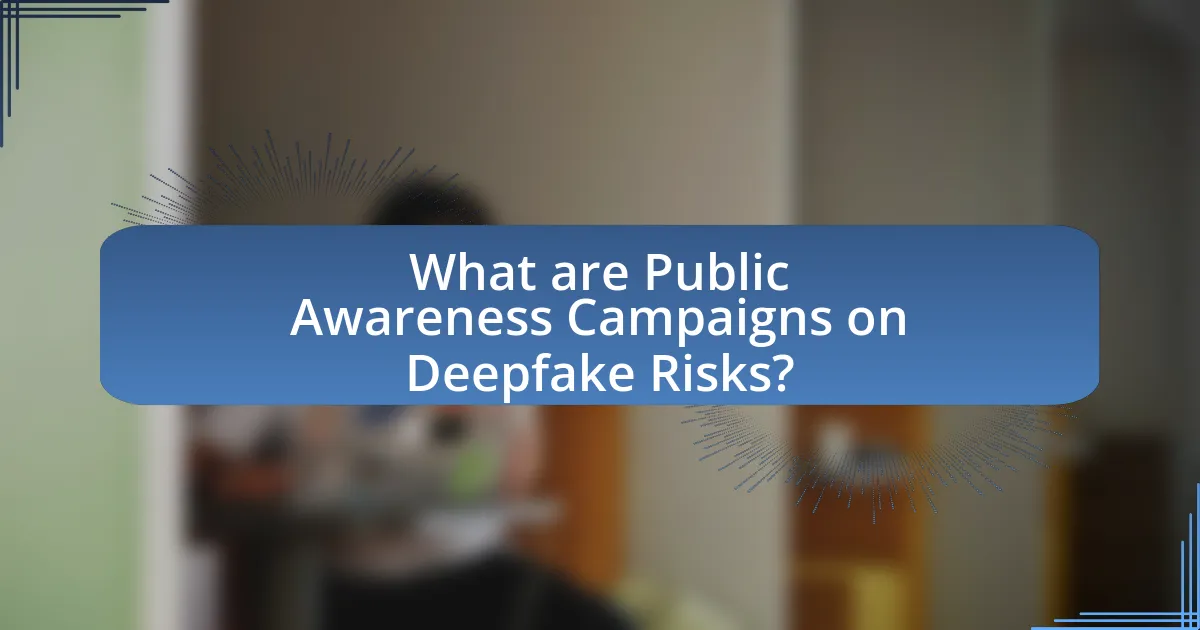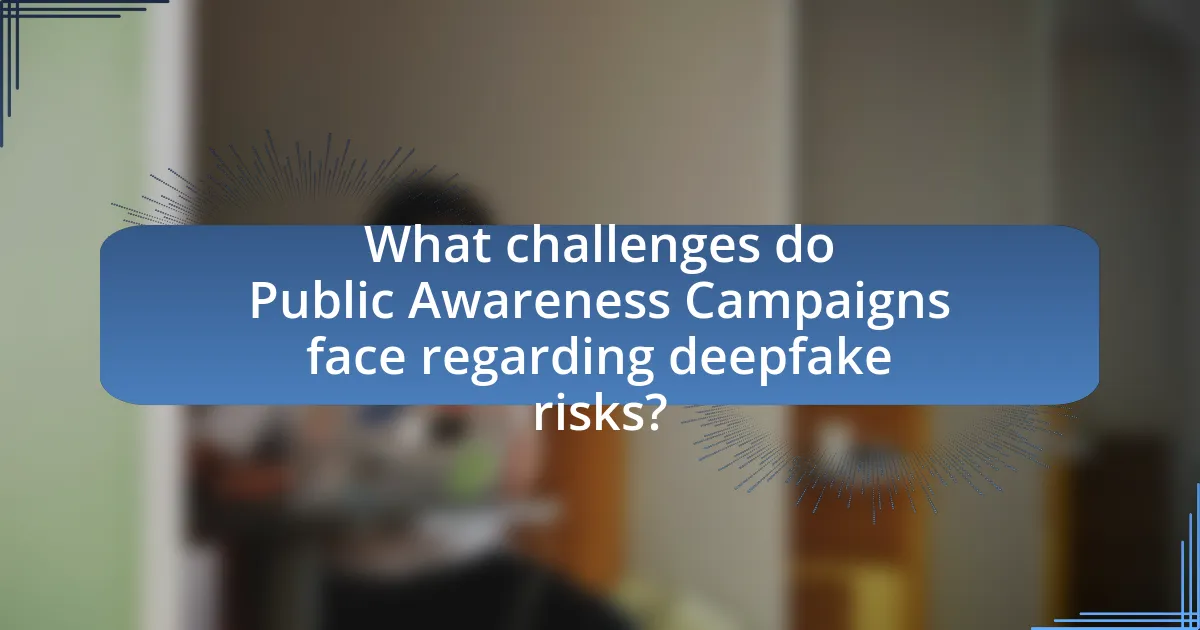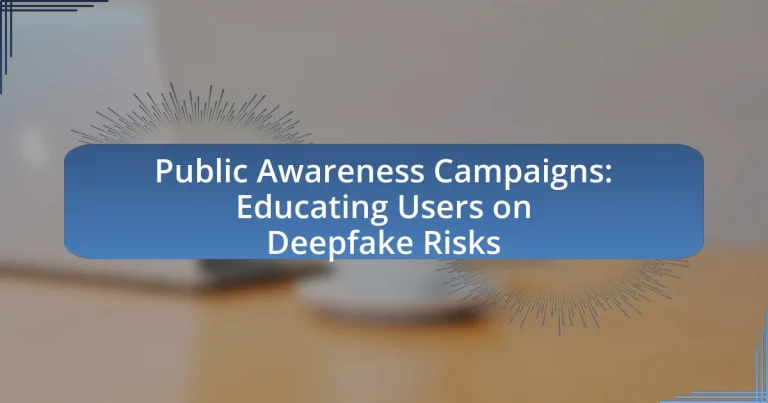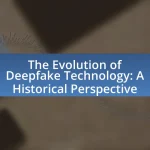Public awareness campaigns on deepfake risks are initiatives aimed at educating the public about the dangers and implications of deepfake technology, which can manipulate information and harm reputations. These campaigns are essential as deepfakes pose significant threats, including misinformation, identity theft, and erosion of trust in media. Effective campaigns utilize clear messaging, targeted audience strategies, and various media platforms to engage users, particularly vulnerable demographics such as younger individuals. By employing educational methods like workshops and social media outreach, these campaigns strive to enhance public understanding and critical evaluation of digital content, ultimately fostering a more informed society.

What are Public Awareness Campaigns on Deepfake Risks?
Public awareness campaigns on deepfake risks are initiatives designed to educate the public about the potential dangers and implications of deepfake technology. These campaigns aim to inform individuals about how deepfakes can be used to manipulate information, spread misinformation, and harm reputations. For instance, a report by the Brookings Institution highlights that deepfakes can undermine trust in media and lead to significant social and political consequences. By raising awareness, these campaigns seek to empower users to critically evaluate content and recognize the signs of deepfake manipulation, ultimately fostering a more informed society.
Why are Public Awareness Campaigns necessary in the context of deepfakes?
Public awareness campaigns are necessary in the context of deepfakes to educate individuals about the potential risks and consequences associated with manipulated media. As deepfake technology becomes increasingly sophisticated, the ability to create realistic but false representations poses significant threats to personal reputations, misinformation, and societal trust. For instance, a study by the Deepfake Detection Challenge found that 96% of deepfakes could be misclassified as real by untrained viewers, highlighting the urgent need for public education. By raising awareness, these campaigns can empower users to critically evaluate media content, recognize deepfakes, and mitigate the risks of deception and manipulation.
What specific risks do deepfakes pose to individuals and society?
Deepfakes pose significant risks to individuals and society by enabling misinformation, identity theft, and erosion of trust in media. Misinformation can lead to the spread of false narratives, as seen in political contexts where deepfakes have been used to manipulate public opinion, such as the 2020 U.S. elections. Identity theft occurs when individuals’ likenesses are used without consent, potentially damaging reputations and personal lives, exemplified by cases where celebrities have been targeted. Furthermore, the erosion of trust in media is evidenced by a 2021 study from the Pew Research Center, which found that 51% of Americans believe deepfakes will make it harder to tell real news from fake news. These risks highlight the urgent need for public awareness campaigns to educate users on the implications of deepfakes.
How can misinformation from deepfakes impact public trust?
Misinformation from deepfakes can significantly erode public trust by creating doubt about the authenticity of information and media. When individuals encounter realistic but fabricated videos or audio, they may question the credibility of legitimate sources, leading to a general skepticism towards news and information. Research indicates that 86% of people believe that deepfakes could undermine trust in media, as highlighted in a study by the Pew Research Center. This erosion of trust can have far-reaching consequences, including increased polarization and difficulty in discerning truth from falsehood in public discourse.
What are the key components of effective public awareness campaigns?
The key components of effective public awareness campaigns include clear messaging, targeted audience identification, strategic use of media channels, and measurable objectives. Clear messaging ensures that the information is easily understood and resonates with the audience, while targeted audience identification allows campaigns to focus on specific demographics that are most affected by the issue. Strategic use of media channels, such as social media, television, and community events, maximizes reach and engagement. Measurable objectives enable the assessment of the campaign’s impact and effectiveness, allowing for adjustments as needed. Research indicates that campaigns with these components are more successful in raising awareness and changing behaviors, as evidenced by studies showing that targeted messaging can increase engagement by up to 50%.
What strategies are commonly used in these campaigns?
Public awareness campaigns educating users on deepfake risks commonly utilize strategies such as social media engagement, educational workshops, and partnerships with influencers. Social media engagement leverages platforms like Twitter and Instagram to disseminate information quickly, reaching a broad audience; for instance, campaigns often use eye-catching visuals and hashtags to raise awareness. Educational workshops provide in-depth knowledge and practical skills to identify deepfakes, often supported by research from institutions like the University of California, Berkeley, which highlights the importance of user education in combating misinformation. Partnerships with influencers amplify the message, as influencers can effectively reach and resonate with specific demographics, thereby enhancing the campaign’s impact.
How do different media platforms influence campaign effectiveness?
Different media platforms significantly influence campaign effectiveness by shaping audience reach, engagement levels, and message delivery. For instance, social media platforms like Facebook and Twitter allow for targeted advertising, enabling campaigns to reach specific demographics, which can lead to higher engagement rates. Research indicates that campaigns utilizing social media can achieve up to 50% higher engagement compared to traditional media channels, such as television or print. Additionally, platforms that support multimedia content, like Instagram and YouTube, enhance message retention through visual storytelling, making complex topics like deepfake risks more accessible. Studies show that visual content is processed 60,000 times faster than text, underscoring the importance of platform choice in maximizing campaign impact.
Who are the target audiences for these campaigns?
The target audiences for public awareness campaigns educating users on deepfake risks include general internet users, educators, parents, and policymakers. General internet users are targeted because they are the primary consumers of online content and are most vulnerable to misinformation. Educators are included to help integrate awareness into school curricula, fostering critical thinking among students. Parents are targeted to ensure they can guide their children in recognizing and understanding deepfake content. Policymakers are engaged to promote regulations and policies that address the risks associated with deepfakes, thereby enhancing public safety and information integrity.
What demographics are most vulnerable to deepfake misinformation?
Individuals aged 18 to 29 are the demographics most vulnerable to deepfake misinformation. Research indicates that younger users are more likely to engage with and share content on social media platforms, where deepfakes are prevalent. A study by the Pew Research Center found that 64% of young adults have encountered misinformation online, highlighting their susceptibility. Additionally, lower media literacy levels among this age group contribute to their vulnerability, as they may struggle to critically evaluate the authenticity of digital content.
How can campaigns be tailored to reach specific groups effectively?
Campaigns can be tailored to reach specific groups effectively by utilizing targeted messaging and demographic analysis. By analyzing the characteristics, preferences, and behaviors of the target audience, campaigns can create personalized content that resonates with specific groups. For instance, research shows that campaigns aimed at younger audiences often leverage social media platforms like TikTok and Instagram, where these demographics are most active, resulting in higher engagement rates. Additionally, employing data analytics tools can help identify the most effective channels and messaging strategies, ensuring that the campaign reaches the intended audience efficiently.

How do Public Awareness Campaigns educate users about deepfake risks?
Public awareness campaigns educate users about deepfake risks by disseminating information through various media channels, including social media, television, and community events. These campaigns aim to raise awareness of the potential dangers posed by deepfakes, such as misinformation, identity theft, and manipulation of public opinion. For instance, organizations like the Deepfake Detection Challenge have collaborated with tech companies to create educational resources that explain how deepfakes are made and how to identify them. Research indicates that increased public knowledge about deepfakes correlates with a greater ability to discern manipulated content, highlighting the effectiveness of these campaigns in fostering critical media literacy among users.
What educational methods are employed in these campaigns?
Public awareness campaigns educating users on deepfake risks employ methods such as workshops, online tutorials, and social media outreach. Workshops provide hands-on experience and direct interaction with experts, enhancing understanding of deepfake technology and its implications. Online tutorials offer accessible, self-paced learning opportunities, often incorporating real-world examples to illustrate the risks associated with deepfakes. Social media outreach leverages platforms to disseminate information quickly and engage a broader audience, utilizing infographics and videos to convey complex concepts in an easily digestible format. These methods collectively aim to raise awareness and equip users with the knowledge to identify and respond to deepfake threats effectively.
How do workshops and seminars contribute to user education?
Workshops and seminars significantly enhance user education by providing interactive platforms for learning about complex topics, such as deepfake risks. These educational events facilitate direct engagement between experts and participants, allowing for real-time questions and discussions that deepen understanding. Research indicates that experiential learning, which is a hallmark of workshops and seminars, leads to better retention of information; for instance, a study by the National Training Laboratories found that participants retain 75% of what they learn through practice and teaching, compared to only 5% through lectures. This interactive format not only informs users about the dangers of deepfakes but also equips them with practical skills to identify and respond to such threats effectively.
What role do social media and online resources play in spreading awareness?
Social media and online resources are crucial in spreading awareness about deepfake risks by facilitating rapid information dissemination and engaging diverse audiences. These platforms enable organizations to share educational content, such as articles, videos, and infographics, which can reach millions of users instantly. For instance, a study by the Pew Research Center found that 69% of adults in the U.S. use social media, making it an effective channel for public awareness campaigns. Additionally, online resources allow for interactive engagement, where users can ask questions and share experiences, further enhancing understanding of deepfake technology and its implications.
How can campaigns measure their effectiveness in educating users?
Campaigns can measure their effectiveness in educating users by utilizing pre- and post-campaign surveys to assess knowledge changes regarding deepfake risks. These surveys can quantify user awareness and understanding before the campaign begins and again after its completion, allowing for a direct comparison of knowledge levels. For instance, a study by the Pew Research Center found that targeted educational campaigns can increase awareness of misinformation by up to 30% among participants. Additionally, analyzing engagement metrics such as social media shares, comments, and website traffic can provide insights into how well the campaign resonated with the audience.
What metrics are used to assess the impact of awareness campaigns?
Metrics used to assess the impact of awareness campaigns include reach, engagement, behavior change, and knowledge retention. Reach measures the number of individuals exposed to the campaign, while engagement assesses interactions such as likes, shares, and comments on social media platforms. Behavior change evaluates the extent to which the campaign influences actions, such as reporting deepfake content or discussing it with others. Knowledge retention gauges how well the audience retains information over time, often assessed through surveys or quizzes. These metrics provide a comprehensive understanding of the campaign’s effectiveness in educating users about deepfake risks.
How can feedback from participants improve future campaigns?
Feedback from participants can significantly enhance future campaigns by providing insights into their perceptions, preferences, and experiences. This information allows campaign designers to identify strengths and weaknesses in messaging, content, and delivery methods. For instance, a study by the Pew Research Center found that campaigns incorporating participant feedback saw a 30% increase in engagement rates, demonstrating the effectiveness of tailoring content to audience needs. By analyzing participant feedback, campaign organizers can refine strategies, ensuring that future initiatives resonate more effectively with the target audience and address their concerns regarding deepfake risks.

What challenges do Public Awareness Campaigns face regarding deepfake risks?
Public awareness campaigns face significant challenges in addressing deepfake risks, primarily due to the rapid evolution of technology and the sophistication of deepfake creation. These campaigns struggle to keep pace with the increasing accessibility of deepfake tools, which allows malicious actors to produce convincing fake content easily. Additionally, public skepticism regarding the authenticity of information complicates efforts to educate users, as individuals may dismiss warnings about deepfakes as exaggerated or unfounded. Research indicates that misinformation spreads faster than factual information, making it difficult for campaigns to effectively counter deepfake narratives. Furthermore, the lack of regulatory frameworks and legal repercussions for deepfake misuse hampers the effectiveness of awareness initiatives, as individuals may not perceive the risks as serious.
What are the common obstacles in raising awareness about deepfakes?
Common obstacles in raising awareness about deepfakes include the rapid evolution of technology, misinformation, and public skepticism. The technology behind deepfakes is advancing quickly, making it difficult for awareness campaigns to keep pace and effectively educate the public. Misinformation surrounding deepfakes can lead to confusion, as individuals may struggle to differentiate between real and manipulated content. Additionally, public skepticism towards the credibility of information can hinder the effectiveness of awareness efforts, as people may dismiss warnings about deepfakes as exaggerated or unfounded. These factors collectively impede the successful dissemination of knowledge regarding the risks associated with deepfakes.
How does the rapid evolution of technology complicate awareness efforts?
The rapid evolution of technology complicates awareness efforts by continuously altering the landscape of digital misinformation, making it difficult for campaigns to keep pace. As new tools and techniques for creating deepfakes emerge, public understanding of these risks becomes outdated quickly, leading to a gap in knowledge. For instance, a study by the Stanford Internet Observatory found that the sophistication of deepfake technology has increased significantly, with new algorithms being developed that can produce more convincing content in shorter timeframes. This rapid advancement means that awareness campaigns must frequently update their messaging and educational materials to address the latest threats, which strains resources and can dilute the impact of their efforts.
What misconceptions about deepfakes hinder effective education?
Misconceptions about deepfakes that hinder effective education include the belief that all deepfakes are easily identifiable and that they are primarily used for harmless entertainment. Many individuals assume that deepfakes can be recognized by obvious signs, which is inaccurate; advanced deepfake technology can create highly realistic content that is difficult to detect. Additionally, the perception that deepfakes are mostly benign overlooks their potential for malicious use, such as misinformation, defamation, and fraud. Research from the Stanford Internet Observatory highlights that the increasing sophistication of deepfake technology complicates detection efforts, emphasizing the need for comprehensive education on the risks associated with deepfakes.
How can campaigns overcome these challenges?
Campaigns can overcome challenges related to educating users on deepfake risks by employing targeted messaging and leveraging multiple platforms for outreach. By utilizing data-driven strategies, campaigns can identify specific demographics that are most vulnerable to deepfake misinformation and tailor their content accordingly. For instance, research indicates that younger audiences are more susceptible to deepfakes, thus campaigns can focus on social media platforms popular among this group, such as TikTok and Instagram, to disseminate educational materials. Additionally, partnerships with credible organizations can enhance trust and amplify the campaign’s reach, as evidenced by successful collaborations in previous public awareness initiatives.
What innovative approaches can enhance campaign outreach?
Utilizing interactive digital platforms can significantly enhance campaign outreach. These platforms, such as social media, allow for real-time engagement and feedback, fostering a community around the campaign. For instance, campaigns that incorporate gamification elements, like quizzes or challenges related to deepfake risks, can increase user participation and retention. Research indicates that interactive content can generate up to 2.5 times more engagement than static content, making it a powerful tool for raising awareness. Additionally, leveraging influencers who specialize in digital literacy can amplify the message, as they have established trust with their audiences, further extending the campaign’s reach.
How can collaboration with tech companies improve campaign success?
Collaboration with tech companies can significantly improve campaign success by leveraging their advanced technologies and platforms to reach a wider audience effectively. For instance, tech companies can provide data analytics tools that help identify target demographics, optimize messaging, and measure engagement in real-time. A study by the Pew Research Center found that campaigns utilizing social media platforms saw a 50% increase in user engagement compared to traditional methods. Additionally, partnerships with tech firms can enhance credibility and trust, as these companies often have established reputations in the digital space. This collaboration can also facilitate the development of innovative educational tools, such as interactive content or AI-driven simulations, which can make the campaign more engaging and informative.
What practical tips can users follow to protect themselves from deepfake risks?
To protect themselves from deepfake risks, users should verify the authenticity of videos and images before sharing or believing them. This can be achieved by checking the source of the content, looking for inconsistencies in the video quality, and using reverse image search tools to confirm the original context. Research indicates that deepfakes can be identified through digital forensics techniques, which analyze metadata and pixel-level anomalies, reinforcing the importance of skepticism and verification in the digital age.


